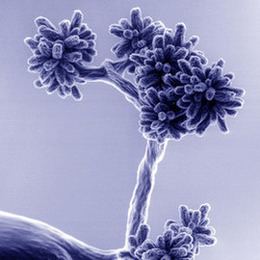Scientific name Myxococcales Rank Order | ||
 | ||
Similar | ||
Myxobacteria form fruiting bodies
The myxobacteria ("slime bacteria") are a group of bacteria that predominantly live in the soil and feed on insoluble organic substances. The myxobacteria have very large genomes, relative to other bacteria, e.g. 9–10 million nucleotides. Sorangium cellulosum has the largest bacterial genome, at 13.0 million nucleotides. Myxobacteria are included among the delta group of Proteobacteria, a large taxon of Gram-negative forms.
Contents

Myxobacteria can move actively by gliding. They typically travel in swarms (also known as wolf packs), containing many cells kept together by intercellular molecular signals. Individuals benefit from aggregation as it allows accumulation of the extracellular enzymes that are used to digest food; this in turn increases feeding efficiency. Myxobacteria produce a number of biomedically and industrially useful chemicals, such as antibiotics, and export those chemicals outside the cell.

Life cycle

When nutrients are scarce, myxobacterial cells aggregate into fruiting bodies (not to be confused with those in fungi), a process long-thought to be mediated by chemotaxis but now considered to be a function of a form of contact-mediated signaling. These fruiting bodies can take different shapes and colors, depending on the species. Within the fruiting bodies, cells begin as rod-shaped vegetative cells, and develop into rounded myxospores with thick cell walls. These myxospores, analogous to spores in other organisms, are more likely to survive until nutrients are more plentiful. The fruiting process is thought to benefit myxobacteria by ensuring that cell growth is resumed with a group (swarm) of myxobacteria, rather than as isolated cells. Similar life cycles have developed among certain amoebae, called cellular slime molds.
At a molecular level, initiation of fruiting body development in Myxococcus xanthus is regulated by Pxr sRNA.
Myxobacteria such as Myxococcus xanthus and Stigmatella aurantiaca are used as model organisms for the study of development.
Clinical use

Metabolites secreted by Sorangium cellulosum known as epothilones have been noted to have antineoplastic activity. This has led to the development of analogs which mimic its activity. One such analog, known as Ixabepilone is a U.S. Food and Drug Administration approved chemotherapy agent for the treatment of metastatic breast cancer.
Myxobacteria are also known to produce gephyronic acid, an inhibitor of eukaryotic protein synthesis and a potential agent for cancer chemotherapy.
